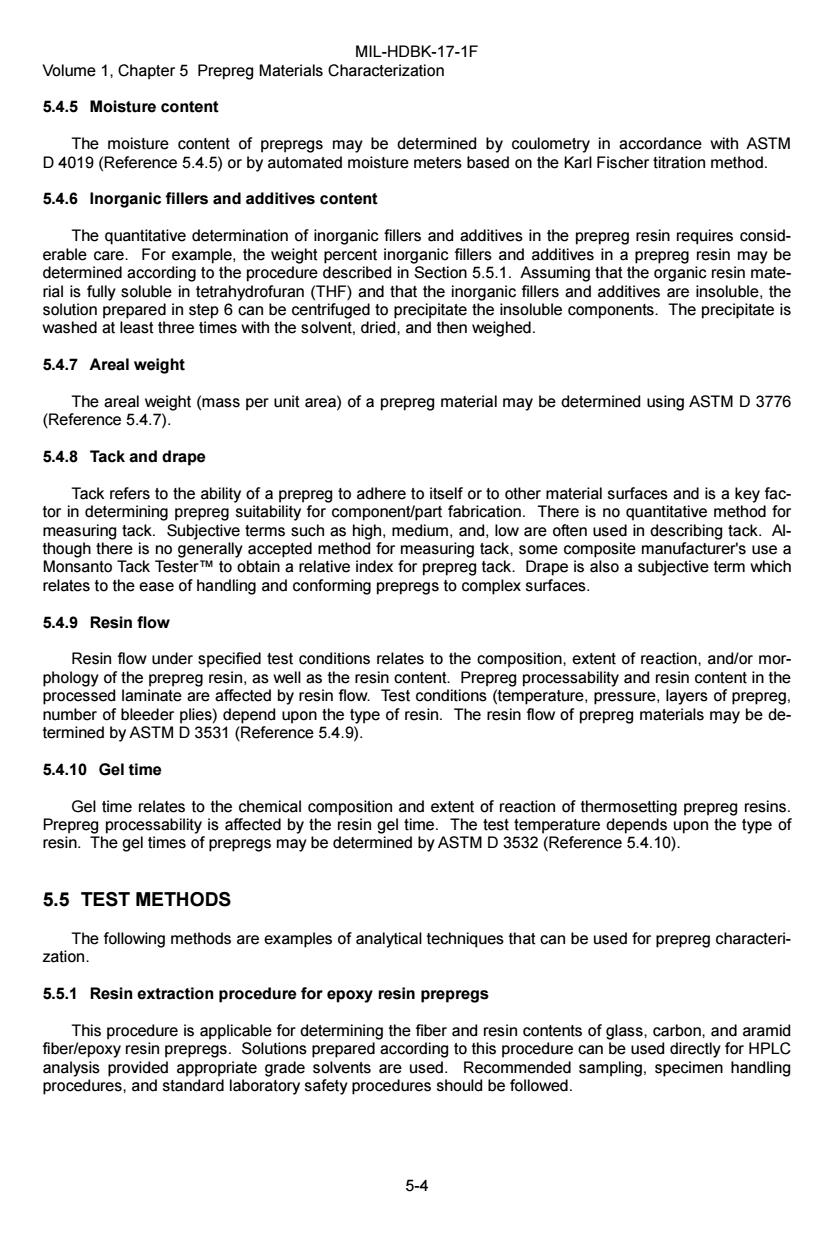正在加载图片...

MIL-HDBK-17-1F Volume 1,Chapter 5 Prepreg Materials Characterization 5.4.5 Moisture content The moisture content of prepregs may be determined by coulometry in accordance with ASTM D 4019(Reference 5.4.5)or by automated moisture meters based on the Karl Fischer titration method. 5.4.6 Inorganic fillers and additives content The quantitative determination of inorganic fillers and additives in the prepreg resin requires consid- erable care.For example,the weight percent inorganic fillers and additives in a prepreg resin may be determined according to the procedure described in Section 5.5.1.Assuming that the organic resin mate- rial is fully soluble in tetrahydrofuran(THF)and that the inorganic fillers and additives are insoluble,the solution prepared in step 6 can be centrifuged to precipitate the insoluble components.The precipitate is washed at least three times with the solvent,dried,and then weighed. 5.4.7 Areal weight The areal weight(mass per unit area)of a prepreg material may be determined using ASTM D 3776 (Reference 5.4.7). 5.4.8 Tack and drape Tack refers to the ability of a prepreg to adhere to itself or to other material surfaces and is a key fac- tor in determining prepreg suitability for component/part fabrication.There is no quantitative method for measuring tack.Subjective terms such as high,medium,and,low are often used in describing tack.Al- though there is no generally accepted method for measuring tack,some composite manufacturer's use a Monsanto Tack TesterTM to obtain a relative index for prepreg tack.Drape is also a subjective term which relates to the ease of handling and conforming prepregs to complex surfaces. 5.4.9 Resin flow Resin flow under specified test conditions relates to the composition,extent of reaction,and/or mor- phology of the prepreg resin,as well as the resin content.Prepreg processability and resin content in the processed laminate are affected by resin flow.Test conditions(temperature,pressure,layers of prepreg, number of bleeder plies)depend upon the type of resin.The resin flow of prepreg materials may be de- termined by ASTM D 3531 (Reference 5.4.9). 5.4.10 Gel time Gel time relates to the chemical composition and extent of reaction of thermosetting prepreg resins. Prepreg processability is affected by the resin gel time.The test temperature depends upon the type of resin.The gel times of prepregs may be determined by ASTM D 3532(Reference 5.4.10). 5.5 TEST METHODS The following methods are examples of analytical techniques that can be used for prepreg characteri- zation. 5.5.1 Resin extraction procedure for epoxy resin prepregs This procedure is applicable for determining the fiber and resin contents of glass,carbon,and aramid fiber/epoxy resin prepregs.Solutions prepared according to this procedure can be used directly for HPLC analysis provided appropriate grade solvents are used.Recommended sampling,specimen handling procedures,and standard laboratory safety procedures should be followed. 5-4MIL-HDBK-17-1F Volume 1, Chapter 5 Prepreg Materials Characterization 5-4 5.4.5 Moisture content The moisture content of prepregs may be determined by coulometry in accordance with ASTM D 4019 (Reference 5.4.5) or by automated moisture meters based on the Karl Fischer titration method. 5.4.6 Inorganic fillers and additives content The quantitative determination of inorganic fillers and additives in the prepreg resin requires considerable care. For example, the weight percent inorganic fillers and additives in a prepreg resin may be determined according to the procedure described in Section 5.5.1. Assuming that the organic resin material is fully soluble in tetrahydrofuran (THF) and that the inorganic fillers and additives are insoluble, the solution prepared in step 6 can be centrifuged to precipitate the insoluble components. The precipitate is washed at least three times with the solvent, dried, and then weighed. 5.4.7 Areal weight The areal weight (mass per unit area) of a prepreg material may be determined using ASTM D 3776 (Reference 5.4.7). 5.4.8 Tack and drape Tack refers to the ability of a prepreg to adhere to itself or to other material surfaces and is a key factor in determining prepreg suitability for component/part fabrication. There is no quantitative method for measuring tack. Subjective terms such as high, medium, and, low are often used in describing tack. Although there is no generally accepted method for measuring tack, some composite manufacturer's use a Monsanto Tack Tester™ to obtain a relative index for prepreg tack. Drape is also a subjective term which relates to the ease of handling and conforming prepregs to complex surfaces. 5.4.9 Resin flow Resin flow under specified test conditions relates to the composition, extent of reaction, and/or morphology of the prepreg resin, as well as the resin content. Prepreg processability and resin content in the processed laminate are affected by resin flow. Test conditions (temperature, pressure, layers of prepreg, number of bleeder plies) depend upon the type of resin. The resin flow of prepreg materials may be determined by ASTM D 3531 (Reference 5.4.9). 5.4.10 Gel time Gel time relates to the chemical composition and extent of reaction of thermosetting prepreg resins. Prepreg processability is affected by the resin gel time. The test temperature depends upon the type of resin. The gel times of prepregs may be determined by ASTM D 3532 (Reference 5.4.10). 5.5 TEST METHODS The following methods are examples of analytical techniques that can be used for prepreg characterization. 5.5.1 Resin extraction procedure for epoxy resin prepregs This procedure is applicable for determining the fiber and resin contents of glass, carbon, and aramid fiber/epoxy resin prepregs. Solutions prepared according to this procedure can be used directly for HPLC analysis provided appropriate grade solvents are used. Recommended sampling, specimen handling procedures, and standard laboratory safety procedures should be followed